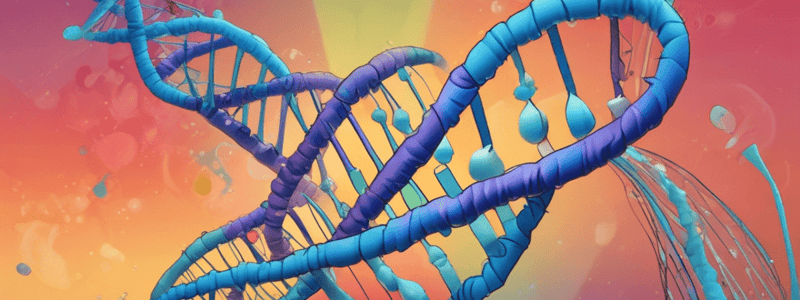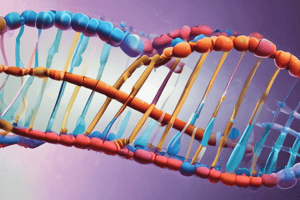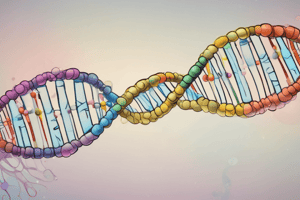Podcast
Questions and Answers
What is the 'backbone' of DNA and RNA composed of?
What is the 'backbone' of DNA and RNA composed of?
- Peptide bonds
- Lipid bilayers
- Phosphate diesters (correct)
- Ribonucleotides
Which enzyme breaks the hydrogen bonds between complementary base pairs during DNA replication?
Which enzyme breaks the hydrogen bonds between complementary base pairs during DNA replication?
- DNA helicase (correct)
- DNA polymerase
- RNA polymerase
- DNA ligase
What is the primary function of DNA gyrase?
What is the primary function of DNA gyrase?
- To synthesize RNA primers
- To break and rejoin DNA strands (correct)
- To bind single-stranded DNA
- To extend the DNA strand during replication
Which of the following is required for DNA replication, but not for RNA replication?
Which of the following is required for DNA replication, but not for RNA replication?
What enzyme provides the catalysis for the 3’ hydroxyl group to attack the α-phosphate of a 5’-deoxynucleoside triphosphate?
What enzyme provides the catalysis for the 3’ hydroxyl group to attack the α-phosphate of a 5’-deoxynucleoside triphosphate?
What role do single-strand binding proteins play in DNA replication?
What role do single-strand binding proteins play in DNA replication?
Which enzyme synthesizes the RNA primer during DNA replication?
Which enzyme synthesizes the RNA primer during DNA replication?
In which direction does DNA polymerase read the leading strand?
In which direction does DNA polymerase read the leading strand?
Which type of organisms have several replication bubbles?
Which type of organisms have several replication bubbles?
What are the short fragments called that are synthesized on the lagging strand?
What are the short fragments called that are synthesized on the lagging strand?
What enzyme is responsible for sealing the backbone of DNA fragments?
What enzyme is responsible for sealing the backbone of DNA fragments?
Which enzyme is part of the replisome complex and adds nucleotides to a growing DNA strand?
Which enzyme is part of the replisome complex and adds nucleotides to a growing DNA strand?
Where does DNA replication begin?
Where does DNA replication begin?
Which enzyme removes the RNA primer and replaces it with DNA?
Which enzyme removes the RNA primer and replaces it with DNA?
Study Notes
DNA Replication - RNA Primase
- DNA polymerase can only add nucleotides to a growing polymer.
- Primase synthesizes a short RNA chain called a primer.
- The primer is a DNA/RNA hybrid for a short stretch.
- Base pairing rules are followed, but A-U instead of A-T.
- The primer is later removed, replaced by DNA, and the backbone is sealed (ligated).
DNA Replication - The Replication Bubble
- Studying replication is easier by considering one replication fork.
- Synthesis is bidirectional.
- Two replication forks moving in opposite directions give rise to a replication bubble.
- Prokaryotes have one replication bubble, while eukaryotes have several.
DNA Replication - Mechanics of It
- DNA is synthesized by adding nucleotides along one strand.
- The leading strand is synthesized continuously.
- DNA polymerase reads 3' → 5' along the leading strand from the RNA primer.
- Synthesis proceeds 5'→ 3' with respect to the new daughter strand.
- The lagging strand is also synthesized 5'-3' because that is the only way DNA can be assembled.
DNA Replication - Okazaki Fragments
- On the upper template strand, DNA synthesis is continuous.
- On the lower template strand, DNA synthesis is discontinuous, resulting in Okazaki fragments.
DNA Replication - DNA Polymerase
- DNA polymerase can only add nucleotides to a growing polymer.
- It is part of the replisome complex with other proteins, such as PCNA.
DNA Replication - Steps Involved
- Replication begins at the origin of replication.
- The strands of DNA separate to form a replication fork.
- RNA primase produces RNA primers.
- DNA polymerase III extends DNA on the leading strand.
- As the replication fork moves, a new RNA primer is made on the lagging strand.
- DNA polymerase III extends these primers, forming Okazaki fragments.
- DNA polymerase I removes the RNA primer, replacing it with DNA.
- The fragments are joined together by DNA ligase.
DNA Synthesis
- Phosphate diesters are the 'backbone' of DNA and RNA.
- DNA polymerase provides catalysis for the 3' hydroxyl group on the end of the growing DNA strand to attack the α-phosphate of a 5'-deoxynucleoside triphosphate, expelling inorganic pyrophosphate.
DNA Replication - Factors Involved
- Exact error-free replication occurs prior to mitosis.
- Replication takes minutes in prokaryotes and hours in eukaryotes.
- Requirements for replication include a primer, template, enzymes, deoxyribonucleotide triphosphates (dNTPs), and ribonucleotide triphosphates.
DNA Gyrase
- DNA gyrase is a topoisomerase II enzyme.
- It causes a double strand break and loops one strand under another.
- It removes a 'turn' of the DNA.
- DNA gyrase is a critical target for blocking cell replication, particularly with antibiotics and antineoplastics.
DNA Replication - Enzymes and Their Functions
- DNA gyrase (topoisomerase II) relaxes supercoiled DNA.
- DNA helicase breaks the hydrogen bonds between complimentary base pairs.
- Single strand binding proteins maintain the stability of the replication fork.
- RNA polymerase (RNA primase) synthesizes RNA primers.
- DNA polymerase synthesizes DNA.
- DNA ligase seals the backbone of DNA.
Studying That Suits You
Use AI to generate personalized quizzes and flashcards to suit your learning preferences.
Description
Understand the role of primase in DNA replication, including the synthesis of RNA primers, and learn about the replication bubble in DNA replication process.




